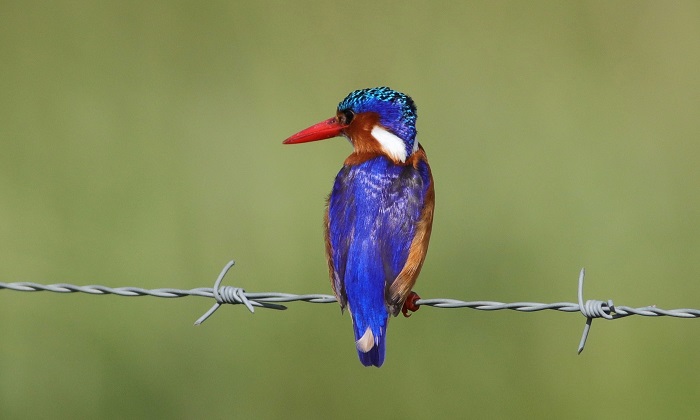Cover image: Malachite Kingfisher by Dawie de Swardt – Dewetsdorp, Free State – BirdPix No.270818
Identification
The jewel-like Malachite Kingfisher is a small, colourful species, and a firm favourite of bird photographers.

Mcaneta, Mozambique
Photo by Ansie Dee Reis
Adult Malachite Kingfishers have deep, yet bright blue upperparts. The blue is slightly paler on the nape and sides of the head, reaching above the eyes to form a blue supercilium. The crown is bright turquoise with black barring. The crown feathers are long and form a crest, especially on the sides, which is not usually raised. The forehead (frons) is orange-chestnut as are the lower sides of the face and neck. The throat is white and there is also an elongate white patch on the side of the neck. The chest and flanks are orange-chestnut and the belly is pale buff or off-white.
The long, straight bill is bright red, as are the legs and feet. The eyes are dark brown. Males and females are alike in plumage colouration.

Keimoes, Northern Cape
Photo by Dieter Oschadleus
Juveniles resemble the adults but are duller and darker in colour and the underparts are brownish-orange. They have black bills, legs and feet that slowly change to red after a few months. The cheeks and breast are variably covered in blackish speckles.
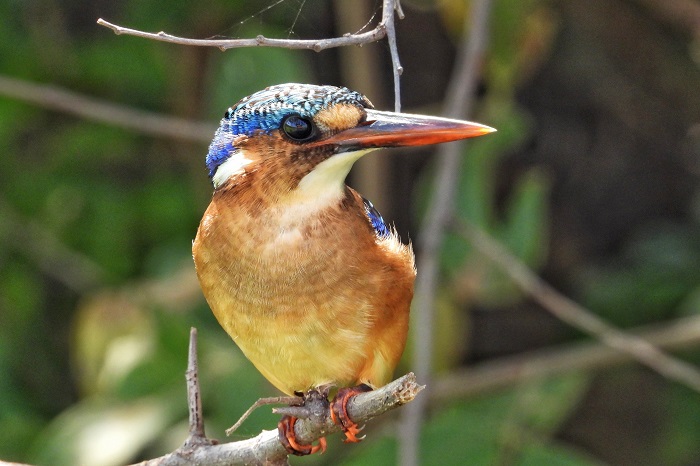
Nylsvlei Nature Reserve, Limpopo
Photo by Neels Putter
In Southern Africa the Malachite Kingfisher is most likely to be mistaken for the African Pygmy Kingfisher (Ispidina picta) and the Half-collared Kingfisher (Alcedo semitorquata).
Adult Malachite Kingfishers are distinguished from the much larger Half-collared Kingfisher by its red bill and orange cheeks. The Malachite Kingfisher more closely resemble the African Pygmy kingfisher but the latter lacks the crest on the crown, and has an orange (not blue) supercilium, pinkish-purple cheeks and more uniformly rufous underparts. African Pygmy Kingfishers are also slightly smaller and inhabit forested or well-wooded habitats, often far from water.
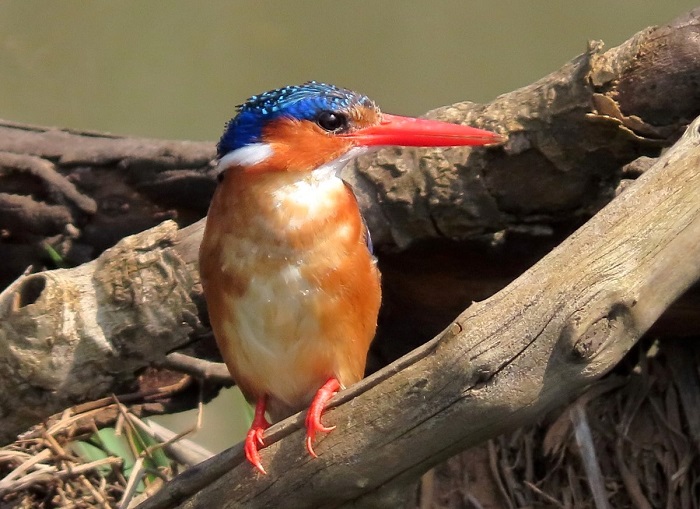
Near Piet Retief, Mpumalanga
Photo by Colin Summersgill
Status and Distribution
The Malachite Kingfisher is a common resident or local migrant. It can be locally abundant in some regions such as the Okavango Delta in Botswana and the coastal areas of KwaZulu-Natal.

Near Hartbeespoort, North West
Photo by Ansie Dee Reis
The Malachite Kingfisher is widely distributed across sub-Saharan Africa. It avoids only the driest regions of north-East Africa and the arid areas of southern Africa, including the Kalahari, parts of the Northern Cape and much of Namibia. The Malachite Kingfisher is uncommon in the tropical forest zone, where it is largely replaced by other closely related species.
In southern Africa it is concentrated in the higher rainfall north, east and south of the subcontinent, extending westwards mainly along the Kunene and Orange River systems.
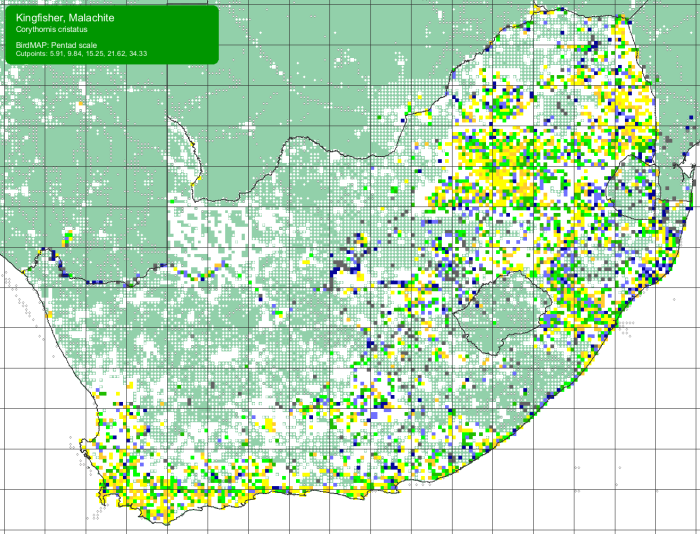
The Malachite Kingfisher is widespread and is not threatened at present. It is locally vulnerable to river pollution, the use of pesticides and habitat destruction.
Habitat
The Malachite Kingfisher is closely associated with aquatic environments. It prefers well vegetated, slow-flowing rivers and streams. The Malachite Kingfisher is also commonly found on dams, marshes, the sheltered shores of large waterbodies, coastal lagoons, tidal estuaries, mangrove swamps, sewage ponds, irrigation canals and ornamental ponds. They also inhabit seasonal streams and ephemeral waters during the wet season. The Malachite Kingfisher sometimes also hunts in coastal rock pools. They avoid habitats with closed tree canopies over the water. Locations with steep banks are required for excavating nest tunnels in the breeding season.

Pongola River, KwaZulu-Natal
Photo by Ryan Tippett
Behaviour
When not breeding Malachite Kingfishers wander to exploit the availability of food. Young birds disperse widely, often flying at night.

Underberg district, KwaZulu-Natal
Photo by Pamela Kleiman
The Malachite Kingfisher is generally a solitary species and is usually encountered along the edges of a waterbody, perching low down on reed or papyrus stems and the exposed branches of bushes and trees. They sometimes also perch on rocks or lengths of wire. It is not particularly shy and, when flushed, flies low over the water, soon to perch again.
Bathes by diving, often repeatedly, before flying off to to perch. They then shake vigorously before preening.

Brandvlei District, Northern Cape
Photo by Johan Van Rooyen
Sits motionless while hunting but occasionally flicks its tail, bobs its head or raises and lowers it crest. Scans the water for signs of prey and once spotted dives at a sharp angle into the water. Most prey is caught within a few centimetres of the surface. If successful, the prey is carried back to a perch in its bill where it is beaten and swallowed whole. Prey may be carried crosswise in the bill, but is always swallowed head first. They may also hawk flying insects from a perch.

Nyerere National Park, Tanzania
Photo by Walter Jubber
Small fish are the preferred prey but the diet of the Malachite Kingfisher is not restricted to fish. They also consume tadpoles, frogs, aquatic insects, dragonflies, terrestrial insects like grasshoppers and beetles, as well as shrimps, crabs and lizards.
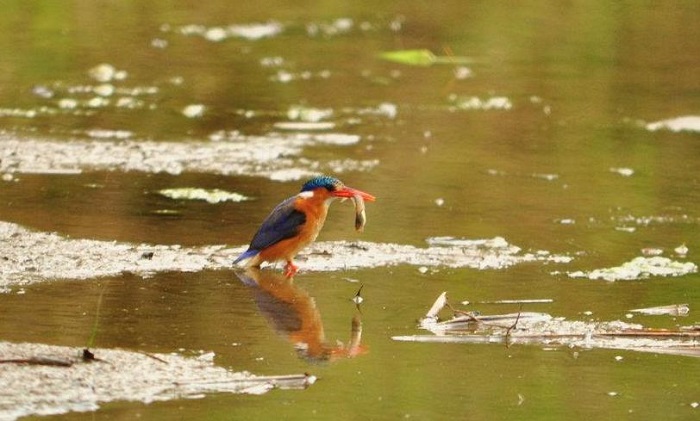
Hluhluwe/iMfolozi Game Reserve, KwaZulu-Natal
Photo by Ryan Tippett
Malachite Kingfishers have a long breeding season in southern Africa, varying slightly from region to region. Breeding generally spans from August to May and often coincides with the low-water period to avoid nests getting flooded.
Malachite Kingfishers are monogamous and territorial. The nest is a tunnel excavated by both sexes in a river or stream bank. Nests are also commonly excavated in road cuttings, earth mounds, in soil around the roots of fallen trees, in the inner wall of Aardvark (Orycteropus afer) burrows or some other hole in the ground. The tunnel is usually around 30 to 90cm long, ending in a small nest chamber. The nest chamber is lined with regurgitated fish bones, scales and arthropod exoskeletons.
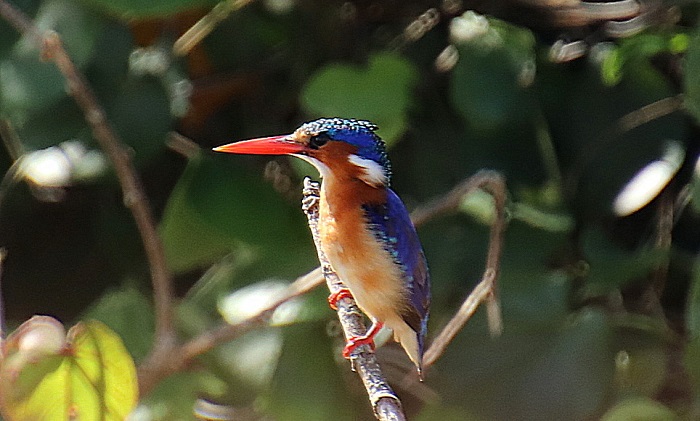
iSimangaliso Wetland Park, KwaZulu-Natal
Photo by Marius Meiring
Anywhere from 3 to 6 glossy white eggs are laid per clutch, and are usually laid at 1 day intervals. Incubation starts once the clutch has been completed and lasts approximately 15 days. Both sexes share in the incubation duties.
The chicks all hatch within 2 days of each other. The nestlings are brooded for warmth mostly by the female and the nestling period lasts around 23 days. Once the young have fledged they start fishing within 1 week of leaving the nest. They remain with the parents for another 15 days or so before the parents chase them away.

Zaagkuilsdrift, Limpopo
Photo by Wiekus Moolman
Malachite Kingfishers are multi-brooded and are capable of raising 3 or 4 clutches during a single breeding season! New clutches are sometimes completed in an adjacent nest, even before the departure of the previous fledglings.
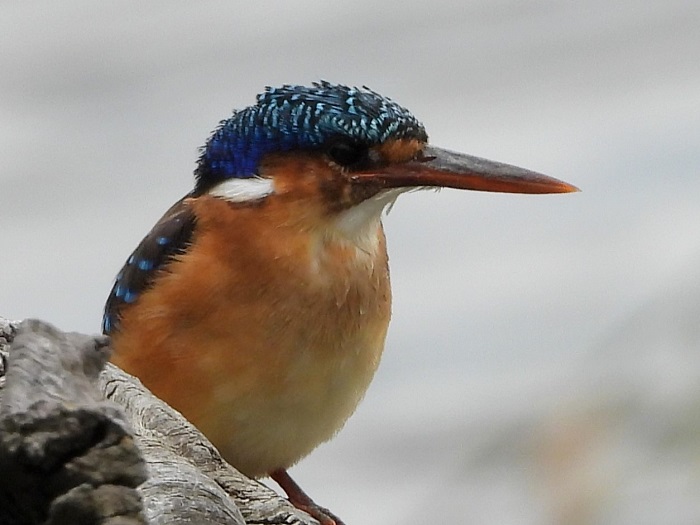
Marievale Bird Sanctuary, Gauteng
Photo by Ansie Dee Reis
Further Resources
This species text is adapted from the first Southern African Bird Atlas Project (SABAP1), 1997.
The use of photographs by Ansie Dee Reis, Colin Summersgill, Dawie de Swardt, Dieter Oschadleus, Johan Van Rooyen Lia Steen, Marius Meiring, Neels Putter, Pamela Kleiman, Walter Jubber and Wiekus Moolman is acknowledged.
Virtual Museum (BirdPix > Search VM > By Scientific or Common Name).
Other common names: Kuifkopvisvanger (Afrikaans); iNhIunuyamanzi, isiKhilothi, uZangozolo (Zulu); Isaxwila (Xhosa); Mmatlhapi, Seinôdi (Tswana); Malachietijsvogel (Dutch); Martin-pêcheur huppé (French); Malachiteisvogel, Haubenzwergfischer (German); Pica-peixe-de-poupa (Portuguese).
List of species available in this format.
Recommended citation format: Tippett RM 2024. Malachite Kingfisher Alcedo cristata. Biodiversity and Development Institute. Available online at https://thebdi.org/2024/05/23/malachite-kingfisher-alcedo-cristata/

Marievale Bird Sanctuary, Gauteng
Photo by Lia Steen

